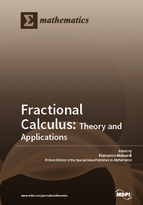Fractional Calculus: Theory and Applications
A special issue of Mathematics (ISSN 2227-7390).
Deadline for manuscript submissions: closed (15 December 2017) | Viewed by 85712
Special Issue Editor
Interests: special functions; fractional calculus complex analysis; asymptotic methods; diffusion and wave propagation problems
Special Issues, Collections and Topics in MDPI journals
Special Issue Information
Dear Colleagues
Fractional calculus, in allowing integrals and derivatives of any positive order (the term fractional is kept only for historical reasons), can be considered a branch of mathematical physics that deals with integro-differential equations, where integrals are of convolution type and exhibit mainly singular kernels of power law or logarithm type.
It is a subject that has gained considerably popularity and importance in the past few decades in diverse fields of science and engineering. Efficient analytical and numerical methods have been developed but still need particular attention.
The purpose of this Special Issue is to establish a collection of articles that reflect the latest mathematical and conceptual developments in the field of fractional calculus and explore the scope for applications in applied sciences.
Prof. Francesco Mainardi
Guest Editor
Manuscript Submission Information
Manuscripts should be submitted online at www.mdpi.com by registering and logging in to this website. Once you are registered, click here to go to the submission form. Manuscripts can be submitted until the deadline. All submissions that pass pre-check are peer-reviewed. Accepted papers will be published continuously in the journal (as soon as accepted) and will be listed together on the special issue website. Research articles, review articles as well as short communications are invited. For planned papers, a title and short abstract (about 100 words) can be sent to the Editorial Office for announcement on this website.
Submitted manuscripts should not have been published previously, nor be under consideration for publication elsewhere (except conference proceedings papers). All manuscripts are thoroughly refereed through a single-blind peer-review process. A guide for authors and other relevant information for submission of manuscripts is available on the Instructions for Authors page. Mathematics is an international peer-reviewed open access semimonthly journal published by MDPI.
Please visit the Instructions for Authors page before submitting a manuscript. The Article Processing Charge (APC) for publication in this open access journal is 2600 CHF (Swiss Francs). Submitted papers should be well formatted and use good English. Authors may use MDPI's English editing service prior to publication or during author revisions.
Keywords
- fractional calculus
- integral transforms and high transcendental functions
- fractional derivatives and integrals
- numerical methods






